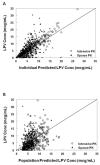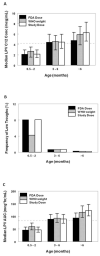Assessment of lopinavir pharmacokinetics with respect to developmental changes in infants and the impact on weight band-based dosing
- PMID: 22190064
- PMCID: PMC3356582
- DOI: 10.1038/clpt.2011.218
Assessment of lopinavir pharmacokinetics with respect to developmental changes in infants and the impact on weight band-based dosing
Abstract
Improved antiretroviral therapies are needed for the treatment of HIV-infected infants, given the rapid progression of the disease and drug resistance resulting from perinatal exposure to antiretrovirals. We examined longitudinal pharmacokinetics (PK) data from a clinical trial of lopinavir/ritonavir (LPV/r) in HIV-infected infants in whom therapy was initiated at less than 6 months of age. A population PK analysis was performed using NONMEM to characterize changes in lopinavir (LPV) PK relating to maturational changes in infants, and to assess dosing requirements in this population. We also investigated the relationship between LPV PK and viral dynamic response. Age and ritonavir concentrations were the only covariates found to be significant. Population PK of LPV was characterized by high apparent clearance (CL/F) in young infants, which decreased with increasing age. Although younger infants had lower LPV concentrations, the viral dynamics did not correlate with initial LPV exposure. Monte Carlo simulations demonstrated that WHO weight band-based dosing recommendations predicted therapeutic LPV concentrations and provided drug exposure levels comparable to those resulting from US Food and Drug Administration (FDA)-suggested dosing regimens.
Figures



References
-
- Joint united nations programme on HIV/AIDS (UNAIDS) and World Health Organization (WHO) AIDS epidemic update: December 2010. Available at: http://data.unaids.org/pub/EPISlides/2010/20101123_GlobalReport_em.pdf.
-
- Nolan M, Fowler MG, Mofenson LM. Antiretroviral prophylaxis of perinatal HIV-1 transmission and the potential impact of antiretroviral resistance. J. Acquir. Immune Defic. Syndr. 2002;30:216–229. - PubMed
-
- Jaspan HB, Lawn SD, Safrit JT, Bekker LG. The maturing immune system: implications for development and testing HIV-1 vaccines for children and adolescents. Aids. 2006;20:483–494. - PubMed

